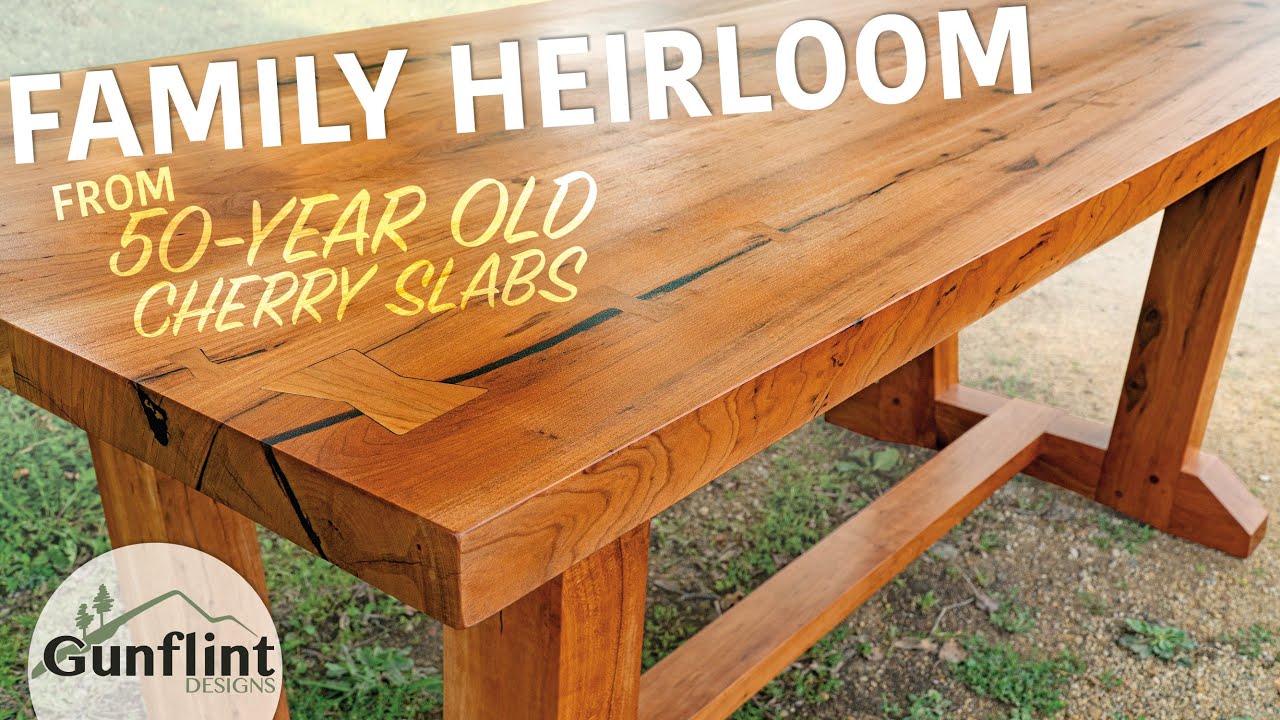This project was built and designed by Mark from Gunflint Designs. It’s a meaningful build using heirloom cherry slabs and features elegant butterfly inlays and epoxy-filled cracks to bring both structure and style to a trestle-style dining table.
Mark created this piece to commemorate his 100th project video—a major milestone in his woodworking journey. The result is a showstopping table that blends traditional joinery, modern materials, and personal history.
Watch the full video and subscribe to Mark’s channel:
From Heirloom Wood to Workbench
The project begins with cherry slabs pulled from Mark’s grandfather’s basement. These slabs made their way across several states before reaching Atlanta, where Mark partnered with Lakeside Woodworks to begin preparing the lumber.
Lakeside’s shop provided access to larger machinery, including a slab master, which made flattening the rough material far more efficient. These early steps helped Mark save hours of manual labor and gave him clean, workable stock for the rest of the build.
Flattening and Smoothing
Using the slab master, high spots were removed until the boards were consistently flat. From there, the slabs were run through a planer to create smooth, uniform surfaces.
Once flattened, the live edges were trimmed and small defects were addressed. This included shaping the layout and identifying key locations for butterfly inlays to stabilize and accent the wood.
Butterfly Inlays Made Easy
Although Mark was initially unsure about tackling butterfly inlays, Rockler’s inlay kit made the process approachable. Templates and a guide bushing allowed him to rout precise recesses in the slabs.
Double-sided tape helped secure the templates during routing. With this setup, Mark was able to cut multiple inlays quickly and accurately, even creating extras for future projects.
Epoxy Filling for Strength and Contrast
To handle cracks and voids in the wood, Mark filled problem areas with epoxy. He tinted the mixture black for visual contrast and poured carefully, allowing the resin to overflow slightly so it could be leveled later.
This step takes time, as the epoxy must cure fully before sanding or surfacing. The dark epoxy paired beautifully with the cherry wood, adding sharp contrast while reinforcing structural weak points.
Final Flattening and Tabletop Glue-Up
With the epoxy cured, Mark planed the surface again to achieve a flat, uniform tabletop. Great care was taken to avoid removing too much material and losing thickness.
A biscuit joiner was used to align the boards during glue-up. Mark arranged the slabs to minimize visible seams and to position the inlays evenly across the surface. A generous application of glue and lots of clamping pressure brought the tabletop together.
Building the Trestle Base
While the glue dried, Mark turned to the table base. He selected matching cherry beams from the same material batch to build the legs and stretchers.
Each board was squared up using the jointer and planer. Maintaining consistency in the angles was critical—Mark used a precision miter gauge to ensure all cuts were at a precise five-degree angle.
Joinery for Strength and Style
Mark joined the leg components using half-lap joints, combining strength and clean lines. After a dry fit confirmed alignment, he drilled for dowels to reinforce the joints and add visual interest.
Careful layout and cutting ensured the legs sat evenly and would support the heavy tabletop. Once satisfied with the fit, Mark glued the components together and clamped everything flat while it dried.
Sanding and Finishing
The fully assembled table was sanded with a series of grits to remove tool marks and prepare the wood for finishing. As the cherry was sanded smooth, its warm grain patterns began to show through beautifully.
For the final finish, Mark used Arm-R-Seal, which offers durable protection and enhances the color and depth of the wood. Several coats were applied with sanding between layers to ensure a smooth, professional result.
A Meaningful Milestone
This project was more than just a piece of furniture—it was a celebration of family heritage and personal progress. The use of heirloom wood, careful detailing, and commemorative inlays made the table deeply personal.
With a solid trestle base and rich finish, the dining table is ready to become a centerpiece for generations to come. Mark hinted at upcoming builds to complement the table, including a set of matching cherry chairs.
You can see all of Mark’s plans here: https://www.gunflintdesigns.com/project-plans.
